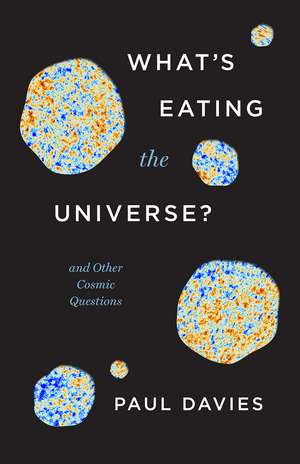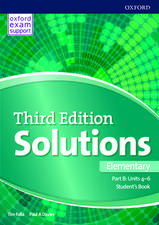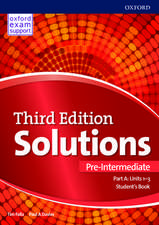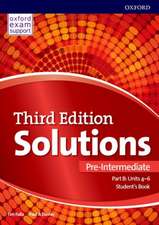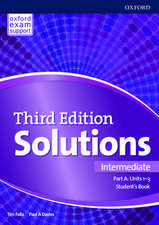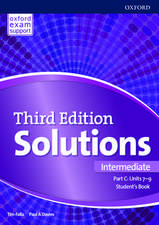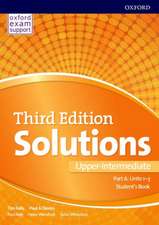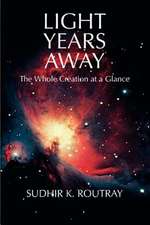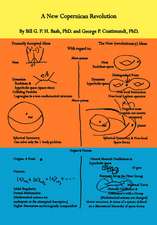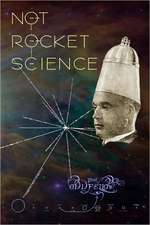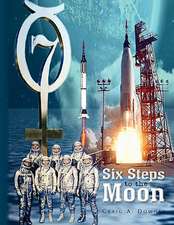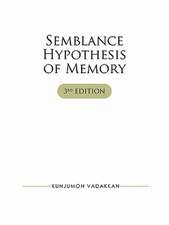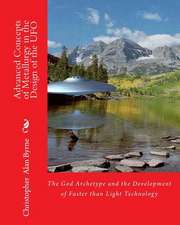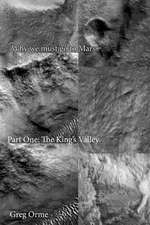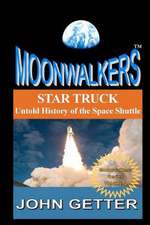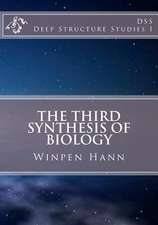What's Eating the Universe?: And Other Cosmic Questions
Autor Paul Daviesen Limba Engleză Paperback – 30 sep 2022
In the constellation of Eridanus, there lurks a cosmic mystery: It’s as if something has taken a huge bite out of the universe. But what is the culprit? The hole in the universe is just one of many puzzles keeping cosmologists busy. Supermassive black holes, bubbles of nothingness gobbling up space, monster universes swallowing others—these and many other bizarre ideas are being pursued by scientists. Due to breathtaking progress in astronomy, the history of our universe is now better understood than the history of our own planet. But these advances have uncovered some startling riddles. In this electrifying new book, renowned cosmologist and author Paul Davies lucidly explains what we know about the cosmos and its enigmas, exploring the tantalizing—and sometimes terrifying—possibilities that lie before us.
As Davies guides us through the audacious research offering mind-bending solutions to these and other mysteries, he leads us up to the greatest outstanding conundrum of all: Why does the universe even exist in the first place? And how did a system of mindless, purposeless particles manage to bring forth conscious, thinking beings? Filled with wit and wonder, What’s Eating the Universe? is a dazzling tour of cosmic questions, sure to entertain, enchant, and inspire us all.
| Toate formatele și edițiile | Preț | Express |
|---|---|---|
| Paperback (2) | 56.67 lei 25-31 zile | +17.96 lei 6-12 zile |
| Penguin Books – sep 2022 | 56.67 lei 25-31 zile | +17.96 lei 6-12 zile |
| University of Chicago Press – 30 sep 2022 | 86.21 lei 22-36 zile |
Preț: 86.21 lei
Nou
Puncte Express: 129
Preț estimativ în valută:
16.50€ • 17.27$ • 13.73£
16.50€ • 17.27$ • 13.73£
Carte disponibilă
Livrare economică 10-24 martie
Preluare comenzi: 021 569.72.76
Specificații
ISBN-13: 9780226823874
ISBN-10: 0226823873
Pagini: 208
Ilustrații: 17 halftones, 1 table
Dimensiuni: 140 x 216 x 18 mm
Greutate: 0.23 kg
Ediția:First Edition
Editura: University of Chicago Press
Colecția University of Chicago Press
ISBN-10: 0226823873
Pagini: 208
Ilustrații: 17 halftones, 1 table
Dimensiuni: 140 x 216 x 18 mm
Greutate: 0.23 kg
Ediția:First Edition
Editura: University of Chicago Press
Colecția University of Chicago Press
Notă biografică
Paul Davies is a theoretical physicist, cosmologist, astrobiologist, broadcaster, and best-selling author. A winner of the prestigious Templeton Prize, he is Regents’ Professor of Physics and director of the Beyond Center for Fundamental Concepts in Science at Arizona State University. He is the author, most recently, of The Demon in the Machine: How Hidden Webs of Information Are Solving the Mystery of Life, also published by the University of Chicago Press.
Extras
Cosmology might seem like a rarefied discipline, but in many indirect ways it touches everyone. We all have a need to know why the world is as it is and how we came to exist. Throughout history, societies have sought to address this need by producing creation myths: accounts which weren’t explanations in the scientific sense but stories intended to place human beings in the context of a grander scheme. When cosmology emerged as a scholarly discipline among the ancient Greek philosophers two and a half millennia ago, it was given a name that derived from the same root as ‘cosmetic’, meaning beautiful, whole and complete; standing in opposition to chaos. The word implied that there was such a thing as ‘a universe’, a coherent and organized entity that can be understood by human reason. Further progress, however, had to await the scientific age two thousand years later, which unleashed a stream of dazzling discoveries. When in 1543 Copernicus declared the Earth goes around the sun, he shattered the human-centric model of the cosmos that had prevailed for centuries. To be sure, the immediate effect on daily life was minor; there were no riots, no wars, no economic disruptions. Yet, over time, the knowledge that we are not located at the centre of the universe fundamentally transformed the context of all human existence. The impact was felt not only in science, but in religion, sociology and economics too.
Today we are poised to undergo a shift in perspective even more disruptive than that initiated by Copernicus. Future generations will look back at our era and envy those privileged to witness it first-hand. But beneath this triumph lies a profound mystery. For some reason, on an unexceptional planet orbiting a run-of-the-mill star, a species of organism evolved that managed to work out how the world is put together. That surely tells us something deeply significant about our place in the natural order. But what?
It’s impossible to look up at the night sky and not be struck by the grandeur and beauty of the vista – the sweeping arc of the Milky Way, the myriad twinkling stars, the insistent, steadfast brightness of the planets. The sheer vastness and complexity are overwhelming. For millennia after millennia, our ancestors observed the same sky, and struggled to make sense of what they saw. What was the key to understanding it? How did the cosmos come to exist? What was the place of human beings in the grand scheme of things?
For many ancient societies, making sense of the heavens was not merely a philosophical or spiritual quest; it was also a practical necessity. Knowing the movement of heavenly objects was critical for human well-being: not just for navigation, but seasonal migration, crop growing and time keeping. Our distant ancestors’ preoccupation with the cycles of the sun, moon and planets is obvious from the megalithic structures they built, some deliberately designed to align with astronomical events – events often imbued with divine significance and marked by elaborate ceremonies. The sky was regarded as the realm of supernatural agents. In some cultures, the sun, moon and planets themselves were treated as gods.
But the regularities evident in the movement of astronomical bodies suggested a very different concept of the heavens, not as the playground of the gods but a mechanism, an elaborate system of moving parts. Once this notion became established, precision measurements were crucial to determine how the mechanism was organized and regulated…
The mechanistic models of the universe were on the right track, but the theological dimension was never eliminated entirely. There was ever the vexatious issue of origins. How did the great cosmic contraption come to exist in the first place? Was there a Prime Mover who set the complex mechanism in motion? A supernatural Creator who conjured order out of chaos? A god who made the universe from nothing? No attempt was made in these early models to link the motion of astronomical objects with the motion of material bodies on Earth. Heaven and Earth, each filled with movement, remained separate domains. This view persisted through much of the Medieval period, until the seventeenth century. Then, suddenly, humankind’s understanding of the universe was transformed. A small band of visionary ‘natural philosophers’ came to realize that the key to the universe was not to be found in divine agency, nor in the geometry of the cosmic architecture itself. Rather, it resides in laws of nature that transcend the physical world and occupy an abstract plane, invisible to the senses but nevertheless within the grasp of human reason. Number and form, beloved of the ancient philosophers, are manifested not just in specific physical objects and systems, but interwoven into the very laws of nature themselves, forming a mosaic of subtle patterns encrypted in a kind of cosmic code. It was a stunning conceptual pivot, marking a transition from mere description of the world to explanation…
Suddenly, humanity possessed a new window on the heavens. The swooping parabolas of comets, the graceful ellipses of planets, the scalloped gyrations of the moon – all the delicate tracery of celestial orbits – fell into place, linked to each other by the immutable logic of fixed mathematical relationships…
Spectacular though such an advance was, Newton had a grander vision. Having explained the solar system, he set about applying his law of gravity to the entire cosmos. Since Galileo had turned his telescope on the Milky Way it was obvious that the universe is teeming with stars. But how were they arranged? Were they clustered in a huge but finite cloud, or scattered endlessly through infinite space? Newton envisaged the cosmos as a gigantic clockwork, with gravity shaping its structure, literally holding it together, a universal force of attraction tugging tenaciously on every object in space. Where gravity is opposed by motion along a curved path, as it is for the Earth going around the sun, stability is attained: our planet is pulled by the sun but doesn’t fall into it. But what about the universe as a whole? With nothing to prop it up, why, wondered Newton, doesn’t the entire assemblage of stars fall together into one great mass?
The solution he proposed was that the universe must be infinite. With no boundary and no centre of gravity, the cosmos lacks any privileged place to collapse towards. A given star would be pulled equally in all directions, the forces balancing out: ‘by their contrary attractions destroy their mutual actions’ was how he quaintly expressed it. Clever though this dodge may have been, it was something of an intellectual sleight of hand. The delicate equilibrium isn’t in fact stable, as Newton himself acknowledged: ‘For I reccon this as hard as to make not one needle only but an infinite number of them . . . stand accurately poised upon their points.’ Newton’s infinite cosmos, it appeared, would teeter on the brink of collapse. Yet as a religious man (albeit in his own eccentric way), Newton did not baulk at invoking the hand of God to sustain His creation when necessary.
And there the matter rested. It was to be another two centuries before the correct solution was found, but through the lens of history we can now see that the answer was hiding in plain sight—right above our heads.
Today we are poised to undergo a shift in perspective even more disruptive than that initiated by Copernicus. Future generations will look back at our era and envy those privileged to witness it first-hand. But beneath this triumph lies a profound mystery. For some reason, on an unexceptional planet orbiting a run-of-the-mill star, a species of organism evolved that managed to work out how the world is put together. That surely tells us something deeply significant about our place in the natural order. But what?
It’s impossible to look up at the night sky and not be struck by the grandeur and beauty of the vista – the sweeping arc of the Milky Way, the myriad twinkling stars, the insistent, steadfast brightness of the planets. The sheer vastness and complexity are overwhelming. For millennia after millennia, our ancestors observed the same sky, and struggled to make sense of what they saw. What was the key to understanding it? How did the cosmos come to exist? What was the place of human beings in the grand scheme of things?
For many ancient societies, making sense of the heavens was not merely a philosophical or spiritual quest; it was also a practical necessity. Knowing the movement of heavenly objects was critical for human well-being: not just for navigation, but seasonal migration, crop growing and time keeping. Our distant ancestors’ preoccupation with the cycles of the sun, moon and planets is obvious from the megalithic structures they built, some deliberately designed to align with astronomical events – events often imbued with divine significance and marked by elaborate ceremonies. The sky was regarded as the realm of supernatural agents. In some cultures, the sun, moon and planets themselves were treated as gods.
But the regularities evident in the movement of astronomical bodies suggested a very different concept of the heavens, not as the playground of the gods but a mechanism, an elaborate system of moving parts. Once this notion became established, precision measurements were crucial to determine how the mechanism was organized and regulated…
The mechanistic models of the universe were on the right track, but the theological dimension was never eliminated entirely. There was ever the vexatious issue of origins. How did the great cosmic contraption come to exist in the first place? Was there a Prime Mover who set the complex mechanism in motion? A supernatural Creator who conjured order out of chaos? A god who made the universe from nothing? No attempt was made in these early models to link the motion of astronomical objects with the motion of material bodies on Earth. Heaven and Earth, each filled with movement, remained separate domains. This view persisted through much of the Medieval period, until the seventeenth century. Then, suddenly, humankind’s understanding of the universe was transformed. A small band of visionary ‘natural philosophers’ came to realize that the key to the universe was not to be found in divine agency, nor in the geometry of the cosmic architecture itself. Rather, it resides in laws of nature that transcend the physical world and occupy an abstract plane, invisible to the senses but nevertheless within the grasp of human reason. Number and form, beloved of the ancient philosophers, are manifested not just in specific physical objects and systems, but interwoven into the very laws of nature themselves, forming a mosaic of subtle patterns encrypted in a kind of cosmic code. It was a stunning conceptual pivot, marking a transition from mere description of the world to explanation…
Suddenly, humanity possessed a new window on the heavens. The swooping parabolas of comets, the graceful ellipses of planets, the scalloped gyrations of the moon – all the delicate tracery of celestial orbits – fell into place, linked to each other by the immutable logic of fixed mathematical relationships…
Spectacular though such an advance was, Newton had a grander vision. Having explained the solar system, he set about applying his law of gravity to the entire cosmos. Since Galileo had turned his telescope on the Milky Way it was obvious that the universe is teeming with stars. But how were they arranged? Were they clustered in a huge but finite cloud, or scattered endlessly through infinite space? Newton envisaged the cosmos as a gigantic clockwork, with gravity shaping its structure, literally holding it together, a universal force of attraction tugging tenaciously on every object in space. Where gravity is opposed by motion along a curved path, as it is for the Earth going around the sun, stability is attained: our planet is pulled by the sun but doesn’t fall into it. But what about the universe as a whole? With nothing to prop it up, why, wondered Newton, doesn’t the entire assemblage of stars fall together into one great mass?
The solution he proposed was that the universe must be infinite. With no boundary and no centre of gravity, the cosmos lacks any privileged place to collapse towards. A given star would be pulled equally in all directions, the forces balancing out: ‘by their contrary attractions destroy their mutual actions’ was how he quaintly expressed it. Clever though this dodge may have been, it was something of an intellectual sleight of hand. The delicate equilibrium isn’t in fact stable, as Newton himself acknowledged: ‘For I reccon this as hard as to make not one needle only but an infinite number of them . . . stand accurately poised upon their points.’ Newton’s infinite cosmos, it appeared, would teeter on the brink of collapse. Yet as a religious man (albeit in his own eccentric way), Newton did not baulk at invoking the hand of God to sustain His creation when necessary.
And there the matter rested. It was to be another two centuries before the correct solution was found, but through the lens of history we can now see that the answer was hiding in plain sight—right above our heads.
Cuprins
Preface
1. Journey from the Edge of Time
2. The Search for the Key to the Universe
3. Why is It Dark at Night?
4. The Big Bang
5. Where is the Centre of the Universe?
6. Why the Cosmos is Actually Fairly Simple
7. What is the Speed of Space?
8. What is the Shape of Space?
9. Explaining the Cosmic Big Fix
10. Most of Our Universe is Missing
11. What is Dark Energy?
12. Where Does Matter Come From?
13. Gravity Conquers All
14. Warped Time and Black Holes
15. Is Time Travel Possible?
16. What is the Source of Time’s Puzzling Arrow?
17. The Black Hole Paradox
18. A Theory of Everything?
19. Fossils from the Cosmic Dawn
20. Can the Universe Come from Nothing?
21. How Many Universes Are There?
22. The Goldilocks Enigma
23. What’s Eating the Universe?
24. Is the Universe Actually a Botched Job?
25. Are We Alone?
26. Is ET in Our Backyard?
27. Why Am I Living Now?
28. The Fate of Our Universe
29. Is There a Meaning to It All?
30. What’s New on the Cosmic Horizon?
Index
1. Journey from the Edge of Time
2. The Search for the Key to the Universe
3. Why is It Dark at Night?
4. The Big Bang
5. Where is the Centre of the Universe?
6. Why the Cosmos is Actually Fairly Simple
7. What is the Speed of Space?
8. What is the Shape of Space?
9. Explaining the Cosmic Big Fix
10. Most of Our Universe is Missing
11. What is Dark Energy?
12. Where Does Matter Come From?
13. Gravity Conquers All
14. Warped Time and Black Holes
15. Is Time Travel Possible?
16. What is the Source of Time’s Puzzling Arrow?
17. The Black Hole Paradox
18. A Theory of Everything?
19. Fossils from the Cosmic Dawn
20. Can the Universe Come from Nothing?
21. How Many Universes Are There?
22. The Goldilocks Enigma
23. What’s Eating the Universe?
24. Is the Universe Actually a Botched Job?
25. Are We Alone?
26. Is ET in Our Backyard?
27. Why Am I Living Now?
28. The Fate of Our Universe
29. Is There a Meaning to It All?
30. What’s New on the Cosmic Horizon?
Index
Recenzii
"Lessons in cosmology and astrophysics abound in this enthusiastic primer from physicist Davies. In answering thirty questions, Davies aims to show how 'beautiful and awe-inspiring' the world is. . . . Accessible writing and a breezy appreciation for discovery make this a great introduction for readers new to physics."
"Dark matter, black holes, dark energy: with all this shadowy terminology in play, it’s no wonder when laypeople find cosmology off-putting, so What’s Eating the Universe? illumines the mysteries of quantum physics in a nonthreatening way."
"A whirlwind tour through the vastness of space and the innermost recesses of subatomic matter. . . . A long career in cosmology, astrobiology, and quantum mechanics gives Davies a keen insight into the realities of research. . . . Like the immense void that gapes across the sky in the direction of the constellation Eridanus, a yawning emptiness that some have suggested may be the sign of another universe set to gobble up our own, the mysteries of space are so vast and so strange that we cannot but be amazed."
"Astrophysicist Davies takes a tour of the cosmos’s grand questions and considers, among other things, supermassive black holes."
"From ancient astronomy and Newton's Law of gravity to dark energy, time loops and extraterrestrial life, the distinguished science writer with a 'short, inspiring and highly entertaining' account of the history of the universe, framed through thirty cosmological conundrums."
"Understanding theoretical physics is a daunting task, but cosmologist Davies’s new book What’s Eating the Universe? is here to guide readers through the field. Davies covers general relativity, antimatter, time travel, the multiverse, and just about any other topic he could fit into the book’s two hundred pages. Each chapter is short—less than ten pages—but jargon-free and full of information. Davies uses a conversational tone to draw the reader in as he skims the history, experiments, and significance of each concept. Regardless of the reader’s prior physics knowledge, the book provides an accessible introduction to cosmology."
"A whistle-stop tour of the biggest mysteries that cosmologists are investigating today. . . . The eponymous chapter details an unexpected void-like cold spot that astronomers have found in the constellation of Eridanus. Speculations follow that our universe might be spontaneously engulfed by a collision with another, or by the quantum vacuum decaying to a lower energy level. If you can bear to contemplate such scary prospects, this book is a fun way of making sure you’re all caught up on where cosmology is at today."
"This is physicist and renowned author Davies’s specialty—providing interesting and provocative commentary on the most profound questions the universe has to offer. And in his compelling new book, What’s Eating the Universe?, Davies excels in succinctly addressing the big intangibles; the cosmological conundrums that haven’t received as much attention as dark matter, dark energy, what triggered the big bang, and the ultimate fate of the universe."
"What's Eating the Universe? gives a concise summary of what we know about the universe, including the Big Bang, inflation, the existence . . . of what we call dark matter and dark energy, the possibility of other universes, black holes and the nature of time—all in around 150 accessible and beautifully written pages that can be read in short, discrete chunks. As a whistle-stop tour, it is breathtaking."
“Why is the night sky dark? Where is the center of the Universe? Is time travel possible? How many universes are there? These are some of the thirty questions that Davies tackles in his latest book. Some of the answers are settled by consensus, others are more speculative; all are thought-provoking. The chapters are arranged roughly in chronological order of the observations and theoretical advances to which they relate, making the book an entertaining and accessible whistle-stop tour of (mostly Western) thinking about cosmology.”
"Recommended [for] all readers."
“Brilliant. You won’t find a clearer, more engaging guide to what we know (or would like to know) about the universe and how it is put together.”
“What’s Eating the Universe? is a veritable feast for curious minds. Davies, a polymath and lyrical writer, masterfully tackles all the big questions ranging from why this Universe to the meaning of life and the significance of the present moment—a whirlwind journey through ideas that have shaped our understanding of the cosmos and its constituents.”
“A whistle-stop tour of the major questions in contemporary cosmology.”
“Davies gives us a thought-provoking, fascinating, and delightful journey through some of the Big Questions that have perplexed and tantalized scientists throughout history. These are the questions and paradoxes that have stumped and teased history’s greatest minds. What happened before the beginning? What is the meaning of the universe? Are there other universes?”
“Davies brings his customary lucidity to a survey of some of the most fascinating and puzzling aspects of our universe, simultaneously educating us about its vertiginous wonders and giving us a real sense of science’s questions as it confronts and explores them and wrestles with their mystery. It is an absorbing and stimulating read, one of the best of its kind.”
“What’s Eating the Universe? is Davies at his very best. He brings a lifetime of experience in explaining mysteries of space and time to offer thought-provoking essays on deep questions in bite-sized, easily digestible chunks. There is no better overview of the advances made by cosmologists in recent decades.”
“Davies has selected a wonderful potpourri of deep questions with incomplete answers. The result is a delightful, fresh-smelling account of the cutting edge of modern cosmology. He is truly exceptional at explaining all of this in his inimitable style—let’s say ‘astropoetry.’”
"A lucid, simple, informative, and good-humored primer on the big questions of modern physics and cosmology, which describes not only the triumphs, but the remaining difficulties. Davies at his best!"
"Davies’ What’s Eating the Universe? is an accessible and engaging introduction to cosmology that will surely pique the interest of students, scholars, and the general public. Davies’ clear and captivating narrative style brings the reader on a journey through cosmological mysteries, while covering a wide range of topics that go beyond the usual fare of popular science books. . . . Davies’s book is a valuable resource for the philosophy classroom and for those philosophers interested in a brief summary of contemporary physical cosmology."
